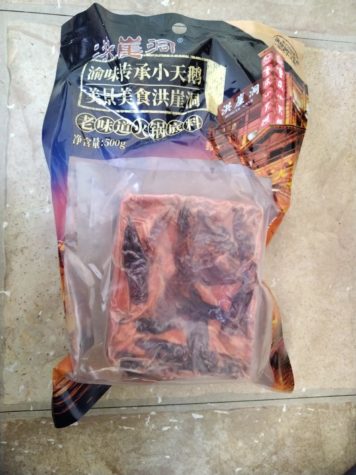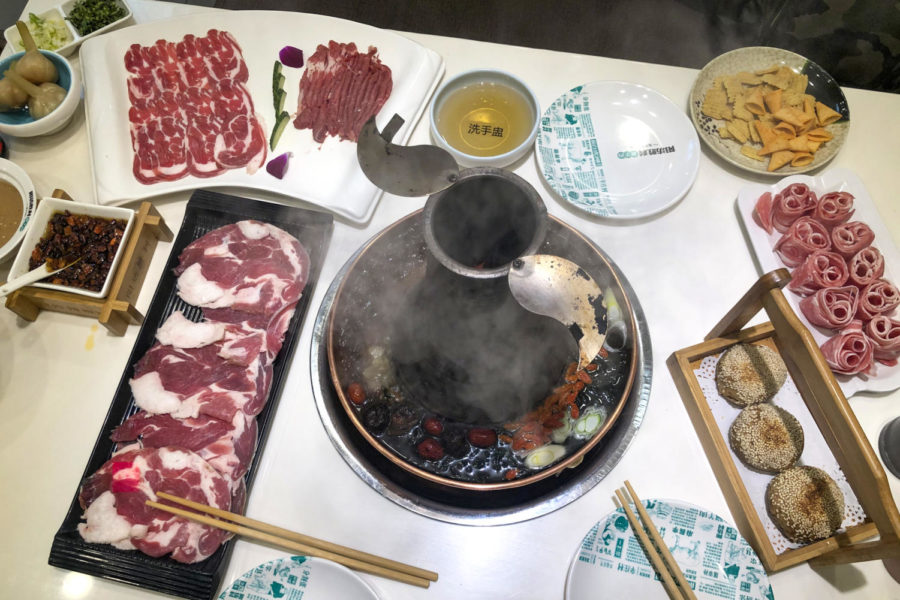The Magical Secret of Hot Pot: Why People Like It So Much
Hot Pot has been gaining popularity recently, but do you know the full history of Hot Pot?
*angys*, CC BY-SA 4.0
Here is a photo of haidilao, a popular multi chained hot pot restaurant. The logo of the restaurant looks like a ‘hi,’ as a welcome for people to come in.
Have you ever seen people waiting in a long line during the winter, in front of an odd looking restaurant with the logo ‘hi’? Later on, you find out that they have been waiting so long just to sit in front of a copper pot. Then you start to wonder again, what is the fun of sitting in front of a plain pot? Well, that pot is no ordinary pot; it is a hot pot, a traditional food amongst people living in many Asian countries. It is a magical pot full of flavors that will warm you up in the winter.
Hot pot is a dish that was invented centuries ago, and people still love its taste, its secret being the soup that boils the food that is put into it. Today there are more than 15 types of hot pot in China and even more around the world. While hot pot itself has changed as it has spread through each country, the main difference comes down to its spices.
The spice in hot pot can be very diverse with up to five different kinds of peppers, butter, and most importantly, the Sichuan peppercorn. The Sichuan peppercorn, produced in Sichuan, China, is what gives the sting on the tongue. Some examples of these spiced hot pot are copper pot, which the people of Beijing especially desire, and Chongqing hot pot, which has a separation in the middle, like a bowl split in half. In just the copper hot pot itself, there can be up to 4 spices, with 3-4 types of dried pepper and 8 spices for the Chongqing one, which is quite a lot for some people to handle.
On the other hand, Hot pots without spice are less diverse, with only water and a few sauces being added. The main purpose of this type of hot pot is to taste the flavor of the food itself rather than letting the spice cover it up. An example of this is the Japanese hot pot, which has a more mild taste compared to the spiced hot pot mentioned before.
So far I have only discussed the type of hot pot that restaurants make, but what about if you want to eat it at home? Companies are now selling mixed spices that taste exactly like the ones sold in restaurants to fill your hungry stomach. If you are in a hurry and can’t cook, there are also instant hot pots, a recent invention where you can add a bottle or two of water to a mix, and the food will cook in less than 10 minutes.
Other than the spices of hot pot, what makes hot pot popular is the way in which it bonds families together. To some, the gathering between families is considered to be the most important aspect of eating hot pot. In a survey that I sent to students at Bronx Science, of the 6 people who tried hot pot, 4 said that connecting with family is what they like about the meal. Another main factor that leads to hot pot’s popularity might simply be friendship. “I never tried hot pot before, but I’m down to try it with my friends,” said Mahdi Chowdhury ’25, in response to whether he would try hot pot.

The President of the Lunar New Year Productions club, Jialing Liu ’24, said that people tend to want to try hot pot when it is recommended by friends. “Especially with the rise of social media, people are now able to convey information at a faster rate. People who made reviews of hot pot often spread many positive messages that encouraged more people to try this delicious dish,” said Liu.”
While the dish was invented in China, there are a few myths about when hot pot was created; one states that the tripod in the Zhou dynasty was a prototype of hot pot. Another myth states that hot pot was invented in the Western Han dynasty, and another said that a hot pot was found in the tomb of Liu He. However, this was later proven to be false, because that pot could only maintain the warmth of food instead of allowing it to be boiled, the main purpose of hot pot today.
The Three-Kingdom Era is considered to be the true date when hot pot was invented, with clear evidence proven in the Book of Wei written by Wei Shou. It was then that the conception of hot pot was developed. As stated in the Book of Wei, hot pot is “铸铜为器,大口宽腹,名曰铜。既薄且轻,易于熟食,” which translates as, “a container made of copper with a big stomach, thin and light, and used to boil cooked food.” In the Three-Kingdom Era, hot pot was also called a five-cooked cauldron, because it was divided into 5 sections. This is similar to the hot pot made today in Chongqing with its design and shape.
Regarding its size and shape, hot pot has not changed much in history since its origin; the five cooked cauldron originated in the Three-Kingdom Era. The only big change that happened in the Northern and Southern dynasties was the shape of the pot. The shapes that were created in the Northern and Southern dynasties turned out to be the copper pots that we use today, and its shape would not change much until stainless steel was created. The stainless-steel pot is another common pot used in hot pot restaurants today, due to the fact that it is very durable and easy to clean. However, one thing that is similar in all these styles is that they usually form the shape of a circle, signifying the unity of a family. The Chongqing and copper hot pot mentioned before is an example of this concept.
Although there were people eating hot pot in the Three-Kingdom Era, hot pot’s popularity really started to rise during the Qing and Ming dynasties. During those eras, hot pot was favored among emperors, where big feasts were held in the emperor’s palace. The Jiaqing Emperor even held a thousand pot feast when he became emperor, using 1,550 silver, copper, and tin pots. The pot itself had also spread its popularity among the peasants, and many styles of hot pot that we have today were developed during that time. Interestingly, hot pot spread to Japan in 1338 during the Muromachi period, and itevolved to be what is known as sukiyaki today, but that is a whole different story.
The world is constantly changing, and so is hot pot. It has evolved from an unknown dish back in the Three-Kingdom Era, to a royal dish during the Qing and Ming dynasties, to its current status as a worldwide phenomenon today. Even though one of hot pot’s main attractions is the ways in which it facilitates gathering with friends and family, who wouldn’t also agree that, “It’s a delicious way to eat food,” as Mingyang Zhou ’25 said.
The world is constantly changing, and so is hot pot. It has evolved from an unknown dish back in the Three-Kingdom Era, to a royal dish during the Qing and Ming dynasties, to its current status as a worldwide phenomenon today.
Fei Ji is a Chief Graphic Designer and a Copy Chief for ‘The Observatory’ yearbook. He is also a Staff Reporter for the school’s newspaper ‘The...












